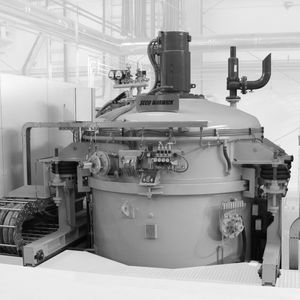
- Company
- Products
- Catalogs
- News & Trends
- Exhibitions
Chamber furnace heat treatmentchemical vapor depositionvacuum
Add to favorites
Compare this product
Characteristics
- Configuration
- chamber
- Function
- heat treatment, chemical vapor deposition
- Atmosphere
- vacuum
- Other characteristics
- environmentally friendly
- Maximum temperature
380 °C
(716 °F)
Description
Vacuum Furnace for Oil Removal
Removing residual oil from the molding or stamping process of parts before subsequent heat treatment.
A vacuum furnace for oil removal is employed to eliminate residual oil from parts produced through molding or stamping processes. This process is conducted prior to further heat treatment, commonly before soldering. It is crucial to ensure the cleanliness of the part before the soldering operation. The oil removal process includes heating the part to the temperature at which the oil evaporates under vacuum conditions. Furnace temperature is meticulously controlled using a multi-zone heating system, enabling precise temperature adjustments. A specially designed pump system extracts oil vapor from the furnace space, and it is then condensed in the outlet system. The recovered oil is stored in a dedicated tank.
Benefits:
/ Customizable according to customer requirements,
/ High-quality and optimal surface protection of parts,
/ Low consumption of energy, process gases, and other utilities,
/ Environmentally friendly with minimal process gas emissions,
/ Simple, modular design tailored and adapted to the tasks and conditions of the plant,
/ Guaranteed quality and reproducible process results,
/ Preventive maintenance support,
/ Remote control and monitoring,
/ Fast delivery and straightforward installation.
Catalogs
No catalogs are available for this product.
See all of SECO/WARWICK S.A.‘s catalogsRelated Searches
- SECO/WARWICK oven
- SECO/WARWICK chamber oven
- SECO/WARWICK electric oven
- SECO/WARWICK heat treatment oven
- SECO/WARWICK laboratory oven
- SECO/WARWICK combustion oven
- SECO/WARWICK gas oven
- SECO/WARWICK tunnel oven
- Baking oven
- SECO/WARWICK industrial oven
- SECO/WARWICK controlled atmosphere oven
- SECO/WARWICK high-temperature oven
- SECO/WARWICK automatic oven
- SECO/WARWICK vacuum oven
- SECO/WARWICK annealing oven
- SECO/WARWICK continuous oven
- Forced convection furnace
- SECO/WARWICK programmable oven
- SECO/WARWICK melting oven
- Air circulating furnace
*Prices are pre-tax. They exclude delivery charges and customs duties and do not include additional charges for installation or activation options. Prices are indicative only and may vary by country, with changes to the cost of raw materials and exchange rates.


















